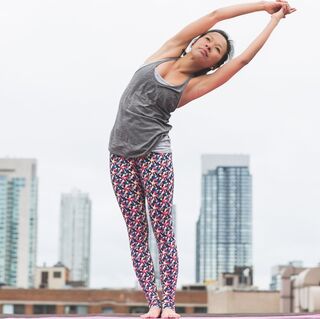Stress
New Study Explores How Yoga Reduces Stress
The mechanisms underlying yoga’s stress-reduction benefits are highlighted.
Posted April 4, 2021 Reviewed by Jessica Schrader
Key points
- Research has found that yoga reduces stress perception and stress reactivity.
- A new study suggests yoga reduces stress by changing one’s psychosocial resources, such as by increasing interoceptive exposure.
- Those receiving conventional treatments for stress, anxiety, or depression may also benefit from doing yoga.

Yoga is a popular form of exercise and stress management. It is assumed to have not only physical benefits (e.g., increased relaxation, enhanced flexibility, better circulation) but also mental health benefits. Recently, the mental health benefits of yoga (e.g., increased positive emotions; decreased depression, anxiety, and stress) have received more research attention; however, many questions remain about the mechanisms involved in how yoga provides these benefits—for instance, it is not clear how yoga reduces stress.
In an article published in the February issue of Stress & Health, Park and colleagues examine potential mechanisms involved in how yoga reduces stress. Specifically, the authors test whether yoga’s beneficial effects on stress are due to any of the following five psychosocial mechanisms: Increases in self-compassion, mindfulness, spiritual well-being, interoceptive awareness, and self-control.
Sample and method
The study involved a yoga intervention. The sample had the following characteristics: 42 individuals; 62% female; average age 41 years, 64% White (12% Asian, 10% Hispanic); average body mass index (BMI) 25; one third with bachelor’s degrees and one half with graduate degrees.
Participants were assessed at time T1 (the beginning), T2 (8 weeks later), and T3 (12 weeks later, when the intervention ended).
The intervention, Kripalu yoga classes, included two segments and lasted 12 weeks in total. The first segment was a manualized introduction to mindful yoga. It was eight weeks long and consisted of two-hour sessions of yoga philosophy and practice (e.g., breathing exercises, relaxation practices, meditation). The second part consisted of four 90-minute weekly sessions.
A variety of scales were administered. These scales measured the following variables:
- Perceived stress (perceptions of life as unpredictable, uncontrollable, and overwhelming)
- Stress reactivity (e.g., feeling agitated, having trouble relaxing)
- Mindfulness (e.g., observing, describing, non-judging, non-reacting, acting with awareness)
- Interoceptive awareness (accurate awareness of the body’s internal states and sensations)
- Spiritual well-being (e.g., faith, sense of meaning and purpose)
- Self-compassion (e.g., self-kindness)
- Self-control (e.g., self-discipline, resisting temptations)
Yoga’s stress reduction mechanisms
The results showed that perceived stress and stress reactivity were correlated with each other and with lower mindfulness, self-compassion, and self-control.
As the intervention progressed, participants reported experiencing less perceived stress (e.g., saw life as more controllable) and less stress reactivity (e.g., found it easier to relax). The former, however, did not reach statistical significance. Nevertheless, the authors found “stronger associations of within-person changes in psychosocial resources with perceived stress than with stress reactivity, suggesting that cognitive/emotional aspects of stress may be most directly linked to the proposed ‘active ingredients’ of a yoga intervention.”
Over the course of the program, participants reported significant increases in their psychosocial resources—particularly increased mindfulness, spiritual well-being, interoceptive awareness, and self-control. Some of these improvements reached statistical significance only by the end of the intervention, suggesting that the length of yoga practice is important.

Of all the psychosocial resources, interoceptive exposure showed the biggest effect size (d = 0.98).
So, yoga’s most immediate and largest benefit appears to be increased awareness and attention to bodily sensations and internal states.
Changes in most of the mechanisms, except self-control, corresponded closely with changes in stress, particularly perceived stress. Changes in self-compassion, in contrast, were more closely associated with changes in stress reactivity.
And mindfulness and spiritual well-being at mid-treatment correlated with perceived stress at mid-treatment and at the end of the treatment.
Mindfulness and spiritual well-being, the authors suggest, might be the “active ingredients” in yoga and meditation programs that succeed in changing perceived stress.
Takeaway
In summary, the present study found a link between the practice of Kripalu yoga and reduced stress reactivity and reduced perceived stress.
In addition, the data showed that mechanisms for the stress-relieving benefits of yoga appear to involve changes in psychosocial resources (e.g., increased interoceptive exposure, increased mindfulness).
The exact mechanisms involved might depend partly on the type of yoga practiced. For instance, Kripalu yoga stresses self-compassion, non-judgmental acceptance, and management of the effects of stress on the body (using specific yoga poses). So Kripalu yoga puts greater emphasis on techniques useful for reducing stress reactivity, as opposed to stress perception.
In comparison, a yoga or meditation program that promotes directing one’s “attention away from stressful experience,” or reappraising “perceptions of events as less stressful” would likely result in a greater reduction in stress perception than reactivity.
Future research is needed to examine other yoga practices (e.g., Bikram yoga, restorative yoga), to determine whether they are more effective in reducing perceived stress or stress reactivity.
The results of the current investigation also indicate that the changes responsible for reduced stress perception and reactivity, like changes in interoceptive exposure, occurred simultaneously as the drop in stress levels. In contrast, conventional psychotherapy (e.g., cognitive-behavioral therapy) usually does not have an immediate effect on stress perception.
So, if you are receiving conventional treatments for stress, anxiety, or depression, you might also benefit from doing yoga. The data reviewed today suggests that practicing yoga reduces stress through different mechanisms (e.g., increased body awareness, mindfulness) than do antidepressants (e.g., SSRIs increasing serotonin levels) and talk therapy (e.g., emotion regulation through challenging erroneous thoughts).
Facebook image: Rido/Shutterstock




